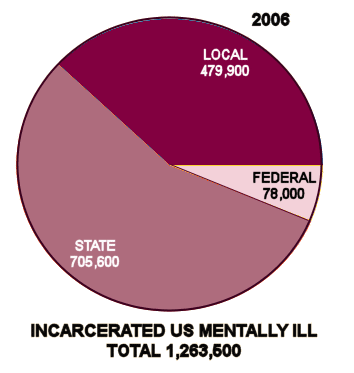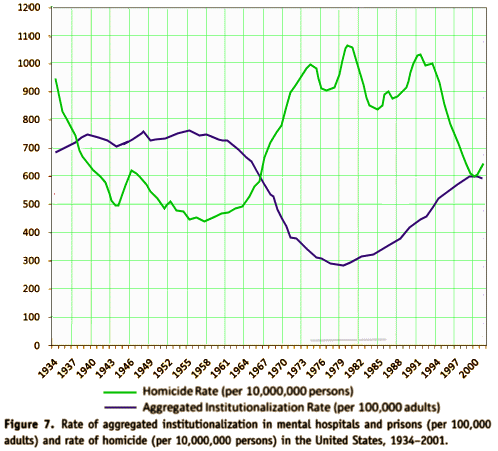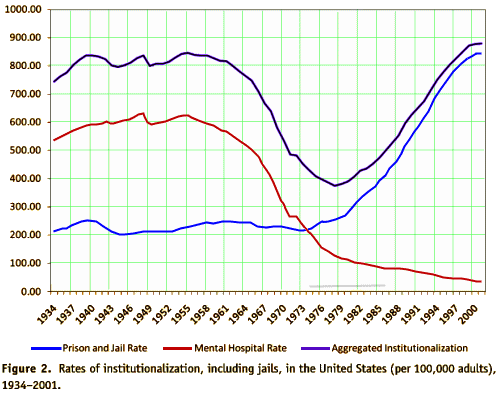Ever since I ran across this graph of the rates of institutionalization, I’ve been mulling over the plight of the severely mentally ill during my time in psychiatry [that faint line above the abscissa marks when I was directly involved]. Writing about it a week or so ago [functional improvement…], I called it Transinstitutionalization – a term from those days predicting that this is what would happen. It does seem naive in retrospect to think that one could Deinstitutionalize the patients in our massive State Hospital system simply by shutting it down. The planned Community Mental Health system was never fully realized, and this graph suggests that the patients essentially moved next door into our prisons:
Looking around to find the magnitude of the problem, I ended up on the National Institute of Corrections web site where I found this:
Mentally Ill Persons in Corrections
 Mentally ill persons increasingly receive care provided by corrections agencies. In 1959, nearly 559,000 mentally ill patients were housed in state mental hospitals. A shift to "deinstitutionalize" mentally ill persons had, by the late 1990s, dropped the number of persons housed in public psychiatric hospitals to approximately
Mentally ill persons increasingly receive care provided by corrections agencies. In 1959, nearly 559,000 mentally ill patients were housed in state mental hospitals. A shift to "deinstitutionalize" mentally ill persons had, by the late 1990s, dropped the number of persons housed in public psychiatric hospitals to approximately  70,000. As a result, mentally ill persons are more likely to live in local communities. Some come into contact with the criminal justice system.
70,000. As a result, mentally ill persons are more likely to live in local communities. Some come into contact with the criminal justice system.
In a 2006 Special Report, the Bureau of Justice Statistics estimated that 705,600 mentally ill adults were incarcerated in State prisons, 78,800 in Federal prisons and 479,900 in local jails. In addition, research suggests that "people with mental illnesses are overrepresented in probation and parole populations at estimated rates ranging from two to four time the general population. Growing numbers of mentally ill offenders have strained correctional systems.
There are so many ways to think about this, most of them suffused with cynicism. When I’m in a cynical mood, I can look at these numbers and cast blame in all directions, but then I come up short, because I’m not really sure what to do about it either. If there is ever a place where the parable of the blind men and the elephant fits like a glove, this is it:

Everyone’s looking at the part that effects them, and the big picture gets lost in the shuffle. Like most mental health types, I tend to accept the MAD vs BAD distinction and want to separate out the mental patients and get them out of the prisons and into the community – the battle cry of my era and the Community Mental Health Movement. Allen Frances and DJ Joffe have an excellent post up that somewhat takes that perspective [see The Hall of Shame – Who Is Failing the Severely Ill?]. I agree with their every word, but always worry that it will fall on deaf ears like it has for such a long time. I was actually impressed with some of the information and policy discussions on the National Institute of Corrections web site as well as a report I found there [Improving Outcomes for People with Mental Illnesses under Community Corrections Supervision:] focused on the parole system. They’re much more mental illness savvy than I realized.
Again, like most mental health types, I look at that pie graph up there and after I get over the magnitude of the problem, I begin to wonder about diagnosis. How many have psychotic illnesses? Are these the homeless chronic patients who have been picked up for minor crimes? How many are primarily substance abusers? I haven’t been able to find those numbers yet, but I’m still looking.
Looking at that graph at the top, I have to remind myself that it is not populations in jail or mental hospitals, it’s rate of institutionalization. They aren’t the patients from the days of Denstitutionalization, they’re a new generation. And it looks to me as if we have a surprisingly fixed rate of removing people from our society for one reason or another. The graph itself is from a study of violent crime – homicide [An Institutionalization Effect: The Impact of Mental Hospitalization and Imprisonment on Homicide in the United States, 1934–2001]. And what it shows is that there was a dramatic increase in the homicide rate in the 1970s and 1980s when Institutionalization had its big dip. It’s a complex legal article, and you’ll have to read it yourself to figure out what they make of their findings:

Dr Jaffe writes:The bipartisan Helping Families in Mental Health Crisis Act (HR3717) has wide support among those who advocate for the 5 percent of the population with the most serious mental illnesses. But there are parts of the mental health industry that ignore the seriously ill. Over 500,000 of the most seriously ill are incarcerated or homeless, largely because the mental health industry focuses on all others.

Both Frances and Jaffe miss the boat completely. Where have they been for the past 30 years? There has been a systematic elimination of both infrastructure other treatment resources to treat addiction and mental illnesses during that time span. I witnessed it first hand during 23 years of inpatient work. In the first phase state and county backed governments eliminated complicated detox on inpatient units and insisted that these patients be sent for “social detox” in county holding tanks. It wasn’t long after that patients were being sent to jail instead of psychiatric facilities for misdemeanor offenses and they often stayed there a long time because of inadequate representation. That was followed by no further commitments for substance use disorders and then shutting down state hospitals and other facilities all together. At the federal level lobbyists and Congress were tripping over on another to eliminate all of these services in the name of the cost effectiveness of managed care.
The laundry lists compiled in this post contains everybody except the responsible parties in this situation.
Let’s get a clue here people and look at who is really to blame. They are not on this list. The effort should NOT be lead by the NIMH which is a basic science research organization. It should also NOT be lead by SAMHSA which as far as I can tell is an organization that thoroughly supports the managed acre industry and managed care strategies – the same strategies that got us to where we are currently.
Re: I begin to wonder about diagnosis. How many have psychotic illnesses? Are these the homeless chronic patients who have been picked up for minor crimes? How many are primarily substance abusers?
This has always seemed to me to be a critical question. I realize the answer varies from state to state but for me this is critical. I was surprised to see this post from Dr. Frances. From my own vantage point, substance abuse plays such a large role in the increase in the prison population. In addition, with the expansion of the DSM, there is an expansion of people who can be labeled as having a mental illness. Now, I am NOT advocating for the jails to be the solution to our drug abuse problems but I think an error is made when we blame the increase in incarceration entirely on deinstitutionalization. We fail to look at other factors in or society – the so-called war on drugs, for instance- that have contributed to the increase.
I am the on the board of NAMI-VT and I work for a member organization of the National Council. I can only speak from my “boots on the ground” perspective. We continue to be very focused on the needs of people who experience psychosis. SAMSHA programs have been helpful to us. I think it is propaganda from TAC that has created a myth that this is not true. At the same time, we are overwhelmed by people who have substance abuse problems. This is a problem for the community and for law enforcement.The state looks at us to provide treatment and we have had a massive increase in programs – many of them are linked to the courts.
I have no doubt that this varies from state to state. I do not believe we have an answer. I just do not think DJ Jaffe has this right, either. He frequently suggests that if one moves away from a purely medical model approach that one is abandoning the most severely mentally ill. This is a hypothesis lacking in actual proof.
“the time for decrying, blaming, or ignoring this has passed…”
I guess I read the Frances/Jaffe post as another decrying and blaming. This type of call to action brings forth proposed solutions when we are not sure of the problem and therefore may not have answers. (maybe it is just me).
I fear that the Murphy bill proposes solutions – gutting SAMHSA if I am up to date on this – that are not going to help. Getting improved mental health care into jails is not going to help if the mental health care involves diagnosing problems and prescribing medications for problems that seem so firmly rooted in poverty, unemployment, etc. At least they do to me. But maybe that is just more decrying or just plain crying. But I am skeptical of top down approaches. I would like to see some smaller scale attempts to turn the tide with more generalization if they seem to work. But then people need to be honest about admitting if a program does not work. It is very hard to solve this.
This is a very personal issue for me. My youngest brother died of liver failure due to alcohol after many contacts with the legal system. Addiction is a very personal issue and must be dealt with by the individual, but jail is also the most expensive way to restrain a person from anti-social behavior.
My other brother, also younger, was shot and killed at work by an individual who had a long history of drug, alcohol, and domestic violence arrest. A young man killed in the prime of life leaving a wife, young daughter, company, and community in shock and at a loss.
When they closed the local mental hospital they simply turned the patients out onto an unsuspecting community. Our church, being downtown, became a magnet for these people seeking services. One person feeling slighted went into the attic and started a fire almost burning our very old gothic church to the ground.
While I was doing my business program I met many kids from Big U doing some of the early work in animal therapy, and today my wife’s sister has a degree in art therapy.
I personally feel we do need a way and place to restrain some individuals. This should be less than jail or prison, but more than the current community based housing. We need to realize that a certain segment of society will always need some type of care.
There is always the hope that these people can move to progressively more liberal housing arrangements and may one day be able to return to society. Until that time we need to protect them from themselves and from us.
This is a slippery slope and profit is never far from the modern medical discussion. Care will need to be taken so as not to return to the warehousing of old. We also need to be aware that some who have been able to stay at home will now need care as their parents are aging and will no longer be able to care for their needs.
Society needs to move away from the pie in the sky theories of some and get down to the nuts and bolts of caring for people. People who for whatever reason cannot care for themselves, no matter what they think.
Steve Lucas
Here is a link to an interesting article that is off topic in most ways – it is about our current foreign relations problems – but it also points to the problems of unintended consequences. Many of the programs and initiatives that we are now decrying were created with good intentions – just as the so-called Murphy bill is today. But these problems are complex and still poorly understood. this is why I would favor smaller scale pilot programs.
http://www.newyorker.com/news/daily-comment/help-know-history?src=mp
… “the nuts and bolts of caring for people”… with “problems that seem so firmly rooted in poverty, unemployment etc”… problems that are “complex and still poorly understood”.
I appreciate the thoughtful comments, although I take issue with a suggestion that lack of understanding is in any way crucial.
Steve Lucas gets it right, in my opinion. His “nuts and bolts of caring for people” is the heart of the problem, I think. We do not need total understanding of complex problems of living in order to secure the basics for human existence, safety, water, food, a roof over one’s head. rest … The Quakers got it right and Loren Mosher, Jaakko Seikkula, Tom Andersen, countless families … Too many excuses for skipping the basics are rooted in vested interests, money, ideology, politics, big egoes, the rampant careerism Wiley mentioned earlier.
berit bryn jensen,
I share your admiration for the same people and yet the implementation of these programs still seems challenging (and in a very small way, I am trying!). For instance, where I live we seem to keep adding programs – some very good ones – and yet the need keeps growing. I honestly do not understand this.
However, to stop decrying and to make suggestions, I would love to see a full implementation of Finnish Open Dialogue in another part of the world. And this is not to discount the work of Mosher or Anderson but what in Tornio they restructured the entire system. But this will never happen via a congressional mandate. We need to try it out somewhere else first and see what translates, what works, what doesn’t. I think very slowly this may be happening.
Perhaps, the numbers are too broad. On the whole, it would be best to keep dangerous people away from the vulnerable. I’d rather see a violent mentally ill person in prison, than in a mental ward with those who desperately need safety. There are, of course, mental hospitals for the criminally insane, but that’s a whole ‘nuther ball of wax and whether or not a particular person would prefer prison to a high security mental ward is probably worthy of an enormous study.
There should be more choices, of course, and focused treatment, but there are many flavors, as you all know, of mental illness and what is called “mental illness”.
Successful drug treatment may solve some problems with violence, but how successful are most drug treatments? There are probably people on the edge of mental illness and mentally well people who suffer from mental illness in prisons from the overused practices of solitary confinement and 24/7 lighting on top of the natural fear of living with violent criminals. From what I’ve read, suicide watch in a prison could probably drive some normal people over the edge.
I think great caution should be used when determining what is needed for a population.
Do you have data on nursing homes too? I think that there are relatively young people with SMI whose medical problems get bad enough that they wind up in general purpose nursing homes in their 50’s.
I’ve also heard that before the advent of the modern nursing home, a lot of old people wound up in mental hospitals.
This would suggest that a fairly constant percentage of the population has remained institutionalized but that they’ve shifted across institutions–from mental hospitals to prisons and mental hospitals to nursing homes.
This is a n article from Larry Davidson about peer supports. One of the criticisms of SAMSHA is in funding peer programs. The critics (and I think DJ Jaffe falls into this category) make the following assumption: people with severe MI can’t recover, therefore programs that promote peers in recovery are not actually for people with severe MI.
http://www.madinamerica.com/2014/09/peer-support-mental-health-exploitive-transformative/
You can’t tackle everything at once and you have to work big to small. The APA and dreamy NIMH wants to tackle 300 diagnoses and brain map and genetically test looking into the future and ignoring the present.
Organized psychiatry needs to put aside about 285 or whatever of its diagnoses for the moment and focus on the 10-15 (as suggested by the original DSM3 St. Louis group) most serious conditions.
Ex-President Lieberman is all gung ho on treating prodromal psychosis, whatever that is, with “neuroprotective” antipsychotics when millions of blatantly psychotic people are rotting in jails.
But I’m a Skinnerian when it comes to psychopolitics. If there’s nothing in it for them, it won’t get done. The talk is altruism, and the walk is self interest. So I don’t expect that all these people with their grant fiefdoms are going to sacrifice anything.
If the history of medicine is a guide to the future, there is and will be animosity, resistance, opposition to anything that rocks the boat of vested interestsm, locally and globally, at corporate and political levels.So any new, healthpromoting approach and treatment may take decades, maybe longer, to be accepted and mainstream. Maybe the public must wake up first, and lead the change? Truth and honesty will prevail, I think, I hope…
Organized psychiatry has become like the Renaissance papacy selling indulgences.
When I finish my 95 theses, whose door should I post it on?
Come on, I guess I am the only one on the Net who believes this: too much of Forensic Psychiatry has made antisocial and sociopathic disorders the purvey of general psychiatry (yes thank you for all that influx of criminals I saw at Frederick and Hagerstown MD the past 9 months!), and, Addiction Psychiatry has sold this horrendously dishonest and disingenuous message that addiction has a psychiatric comorbidity of 80%, if not more.
BS! I have still not seen more than 50% of true addicts be genuinely psychiatrically impaired if they get clean and maintain it for more than 3 or more months. Again, just adding that 30% or more to community mental health clinics to bear the burden. Oh, yeah, remember that over 90% of these above two patient groups don’t go to private practices, but, to overworked, overburdened, and understaffed CMHCs that just wither with these noncompliant, noninvested, and drug seeking people.
So, wax poetic with the academic dialogue above, at the end of the day, who really is impacted by this “Correctional Psychiatry” bulge? My bet is less than 10% of the commenters at sites like this. The real problem is, you can bet the administrators of these CMHCs don’t give a rat’s behind, because they are de facto politicians and do what is popular, easy, and convenient, and dare not ruffle the feathers of the outright politicians who insist these convicts go to state CMHCs, because someone has to show the public they care.
After all, it is an election year for most, eh?